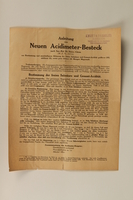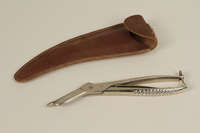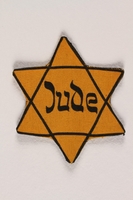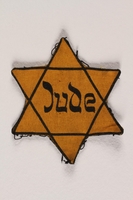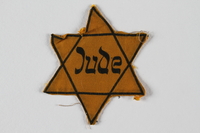Overview
- Credit Line
- United States Holocaust Memorial Museum Collection, Gift of Heinz Boehm
- Markings
- front, center, black ink : Jude [Jew]
Physical Details
- Language
- German
- Classification
-
Identifying Artifacts
- Category
-
Badges
- Object Type
-
Star of David badges (lcsh)
- Physical Description
- Yellow cloth badge in the shape of a 6 pointed Star of David stiched to black cloth backing. The star outline is formed from 2 overlapping, dyed triangles and has German text in the center.
- Dimensions
- overall: Height: 3.700 inches (9.398 cm) | Width: 3.110 inches (7.899 cm)
- Materials
- overall : cloth, dye, ink
Rights & Restrictions
- Conditions on Access
- No restrictions on access
- Conditions on Use
- No restrictions on use
Administrative Notes
- Legal Status
- Permanent Collection
- Provenance
- The Star of David badge was donated to the United States Holocaust Memorial Museum in 1999 by Heinz Boehm.
- Record last modified:
- 2022-07-28 18:23:46
- This page:
- https://collections.ushmm.org/search/catalog/irn13613
Download & Licensing
In-Person Research
- By Appointment
- Request 21 Days in Advance of Visit
- Plan a Research Visit
- Request to See This Object
Contact Us
Also in Dr. Willy Katz collection
The Dr. Willy Katz collection consists of ten medical instruments used by Dr. Katz in his medical practice in Dresden (reflex hammer, two forceps, otoscope, clippers, forceps, caliper, curette, medical scissors and case, acidimeter, and instructions for the acidimeter); four Star of David badges; and a collection of archival papers including biographical materials, correspondence, photographs, printed materials, and subject files documenting Dr. Katz’s medical service during World War I; his first wife, their child, and his second wife; and his work as the head of the Jewish health care center in Dresden during World War II.
Date: approximately 1880-1988
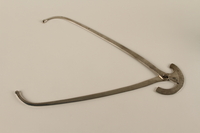
Caliper
Object

Reflex hammer
Object
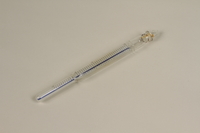
Acidimeter
Object
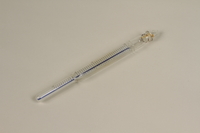
Acidimeter
Object

Curette
Object
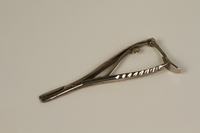
Forceps
Object
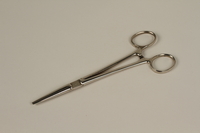
Forceps
Object
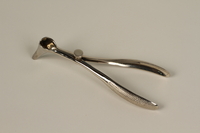
Otoscope
Object
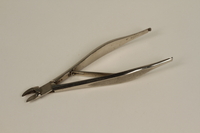
Clippers
Object
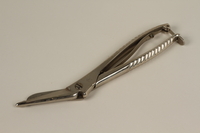
Medical scissors
Object
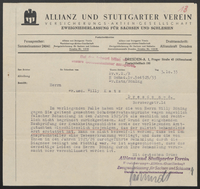
Dr. Willy Katz papers
Document
The Dr. Willy Katz papers consist of biographical materials, correspondence, photographs, printed materials, and subject files documenting Dr. Katz’s medical service during World War I; his first wife, their child, and his second wife; and his work as the head of the Jewish health care center in Dresden during World War II. Biographical materials include certificates, military records, questionnaires, medical records, and a memorial service description documenting Dr. Katz’s service in World War I, his marriage to Helene Katz, his medical practice during World War II, his illness, and death in 1947. This series also includes his second wife’s passport, bank identification card, and brief biographical history as well as a questionnaire he completed for his son during the war. Correspondence files primarily include correspondence among Dr. Katz, German governing bodies, and Jewish agencies related to his work as head of the Jewish health care center in Dresden. The records document Dr. Katz’s appointment as the head of the health care center, as school physician, and as home inspector; payments and reimbursements for his services; his appeals to be exempted from wearing the yellow star; restrictions on Jewish lives and the treatment of Jewish patients; participation in charitable activities; the assessment of patients’ ability to work; patient transfers; and treatment requirements and options for specific patients. Correspondence files also include two letters from a Katz relative imprisoned at Buchenwald and a number of postcards from friends and acquaintances of Dr. Katz imprisoned at Theresienstadt. Photographic materials consists of photographs, photograph album, and loose album pages documenting Dr. Katz’s first wife, Elsa Brann, during her World War I nursing service, in uniform, and with patients; Dr. Katz during his World War I medical service, in uniform, and with other officers; Helmut Katz with his mother and stepmother and as a grown man; and the Katz family together. Printed materials include a copy of a German medical newspaper containing an article about Heinz Böhm and his relationship with Dr. Katz and Elsa Brann’s copy of an art book about Anthony Van Dyck. Subject files consist of correspondence and legal records documenting an unsuccessful malpractice suit filed against Dr. Katz; name lists of Jewish patients in Dresden; and policies and regulations governing German Jews and their medical treatment.

